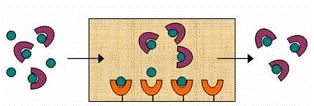Department of Chemistry
Document Type
Article
Date of this Version
2-15-2007
Citation
Published in final edited form as: Anal Chem. 2007 February 15; 79(4): 1411–1424. doi:10.1021/ac061779j. Version presented here is from NIH PubMed Central.
Abstract
Two techniques were developed for the immobilization of proteins and other ligands to silica through sulfhydryl groups. These methods made use of maleimide-activated silica (the SMCC method) or iodoacetyl-activated silica (the SIA method). The resulting supports were tested for use in highperformance affinity chromatography by employing human serum albumin (HSA) as a model protein. Studies with normal and iodoacetamide-modified HSA indicated that these methods had a high selectivity for sulfhydryl groups on this protein, which accounted for the coupling of 77–81% of this protein to maleimide- or iodacetyl-activated silica. These supports were also evaluated in terms of their total protein content, binding capacity, specific activity, non-specific binding, stability and chiral selectivity for several test solutes. HSA columns prepared using maleimide-activated silica gave the best overall results for these properties when compared to HSA that had been immobilized to silica through the Schiff base method (i.e., an amine-based coupling technique). A key advantage of the supports developed in this work is that they offer the potential of giving greater site-selective immobilization and ligand activity than amine-based coupling methods. These features make these supports attractive in the development of protein columns for such applications as the study of biological interactions and chiral separations.



Comments
Copyright American Chemical Society. Used by permission.